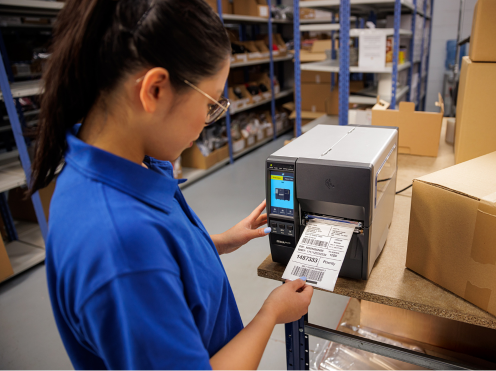
Label Printers are an essential tool for many businesses, whether you run a small e-commerce site or have a large manufacturing plant, label printers play a critical function in business operations. With the large number of label printers available it can be difficult to choose a model that is suitable for your exact requirements. In this guide we discuss ten things to consider to help choose the right label printer for your business.
1. Type of printer required
The first question to consider is what type of label printer is suited to your requirements. The three main categories of label printers are 1) Direct thermal label printers 2)Thermal transfer label printers 3) Inkjet label printers. Direct thermal and thermal transfer printers are types of thermal printers which are used for mono coloured printing such as barcode printing and receipt printing. Direct thermal printers are suitable for applications requiring a short shelf life such as shipping labels and receipts. Thermal transfer printing is suitable for long life applications such as asset labels and laboratory labeling. Inkjet label printers produce high-quality full colour labels and are suitable for producing coloured labels required for applications such as product labels.
2. Print Volume
Determining the volume of labels you will be printing daily/weekly/monthly is important as there are different categories of label printers that can handle varying volume requirements. For low volume printing a desktop label printer is suitable. For mid volume requirements a mid-range printer is suitable. For high volume requirements an industrial printer is suitable.
3. Budget
With the large number of label printers available, there are models to suit varying budget requirements. When determining your budget for a label printer it is important to factor in the initial cost of the printer as well as the ongoing operating costs which includes the cost of consumables including labels, ribbons (where required), ink (where required) and maintenance supplies. Thermal printers generally have lower ongoing costs when compared to inkjet printers. It is also important to consider the potential maintenance costs for future issues and repairs. Repairs on label printers can be expensive so it’s worth considering the length of the manufacturer's warranty as well as the cost of a maintenance contract which can reduce repair costs in the long term.
4. Label size and label format
Label printers have varying minimum and maximum label sizes they can accept, when choosing a label printer it’s important to know your label dimension requirements as this will narrow down suitable printers. It is also important to consider the types of media the printer can handle including rolls, fan-folded and continuous labels.
5. Print speed
Label printers have varying print speeds which is measured by millimeters of print per second. The importance of print speed as a consideration depends on the volume of labels that are being printed. If you are printing thousands of labels per day, print speed will be an important consideration, it can be very frustrating if a printer is slowing down production processes and productivity. Contrastingly if a dozen labels are being printed per day, a fast print speed won’t be an important factor to consider.
6. Print resolution
The resolution of a printer is measured by DPI (dots-per-inch, how many dots of ink can be printed per square inch). The higher the DPI of a printer the higher the resolution and print quality. Thermal printers typically are either 203dpi, 300dpi or 609dpi contrastingly inkjet label printers have much higher resolutions as they are intended for printing detailed designs. For thermal printers if you are printing very small text or barcodes a higher resolution printer may be required. For inkjet label printers the label design that is being printed will help determine the importance of DPI. If a label design contains very fine details and colour variations a printer with a high DPI will be required to produce a sharp image.
7. Printer connectivity and operating system compatibility
When choosing a label printer it is important to consider what connectivity is required for your business needs. Label printers come with varying interfaces which include USB, Ethernet, Wi-Fi and bluetooth connections. When choosing a label printer you should also check the printer is compatible with your operating system as many printers are not compatible with macOS. It is important to verify that the printer drivers are available for your operation system whether it’s Windows, macOS or Linux.
8. Printer Software Integration
Many customers will typically use a label design software which includes packages from BarTender, NiceLabel, Zebra Designer, if you plan on using these packages make sure to check the label printer is compatible. If you require a label printer to integrate with your own industry software it is important to check that the label printer can integrate with your current inventory, shipping or point-of-sale systems ect.
9. Optional Features
When purchasing a label printer we would recommend considering if certain optional features may be suitable for your application. Features which you should consider include an inbuilt label cutter which can cut continuous media to various sizes.This is a useful cost saving tool when there are various label sizes being printed. A feature which may be required for some applications is a built-in dispenser which automatically removes the label backing paper presenting a label ready to apply.
10. Future proof your investment
Label printers can be a costly investment therefore it’s important to consider your potential future label printing requirements as you do not want to quickly outgrow your printer. We suggest choosing a printer that can handle increased volume requirements if you plan on expanding your business fairly quickly.